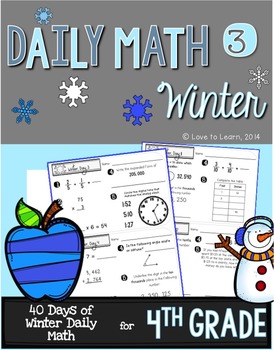Daily Math 3 (Winter) 4th Grade
Love to Learn and Teach
8k Followers
Resource Type
Standards
CCSS3.MD.A.1
CCSS4.MD.A.1
CCSS4.MD.A.3
CCSS4.MD.B.4
CCSS4.MD.C.5
Formats Included
- PDF
Pages
27 pages
Love to Learn and Teach
8k Followers
Also included in
- This unit contains all 6 of my Daily Math packs for fourth grade students. Used throughout the school year, these sheets are designed to spiral in difficulty, beginning with a review of Third Grade Common Core Standards in the Back to School pack and ending with a review of Fourth Grade Common CorePrice $18.00Original Price $20.00Save $2.00
Description
This unit is the third in my Fourth Grade Daily Math series. Great for morning work or homework, this unit contains 40 days of Winter Daily Math for 4th grade students. These sheets are created to continue the transition from the third grade Common Core Standards to the fourth grade common core standards by the continued study of multiplication (basic and multi-digit), division, fractions (addition and subtraction), angles, area, and perimeter. In this unit the concept of decimals (tenths and hundredths) is included. In addition to these concepts, place value, multi-digit addition and subtraction, telling time, and money are also included to reinforce basic skills.
Some of the topics covered in this packet include:
- multiplication and division within 100.
- solving word problems involving the four operations.
- rounding numbers to any place.
- addition and subtraction within 1000.
- representing numbers in written and expanded forms.
- comparing and ordering numbers.
- multiplying 1-digit whole numbers by multiples of 10.
- generating number patterns.
- representing fractions on a number line.
- comparing fractions.
- addition and subtraction of fractions.
- comparing decimals.
- telling time to the nearest minute.
- comparing units of measurement.
- answering questions involving bar graphs.
- symmetry of polygons.
- identifying parallel and perpendicular lines.
- identifying acute, right and obtuse angles.
Each page in this packet contains two days of Daily Math, with five questions for each day. Each day covers various Common Core Standards, in the attempt to provide students with a comprehensive review of skills.
These pages can be provided to students at the beginning of a math period, be placed in a math center for independent work, or can be given as homework to students in need of a skill review.
**Answer Keys included**
Please note that this unit is included in my Daily Math Fourth Grade Bundle Pack, which contains a full year of Daily Math: Daily Math Fourth Grade Bundle Pack
Thank you for looking!
- Love to Learn, 2012
Some of the topics covered in this packet include:
- multiplication and division within 100.
- solving word problems involving the four operations.
- rounding numbers to any place.
- addition and subtraction within 1000.
- representing numbers in written and expanded forms.
- comparing and ordering numbers.
- multiplying 1-digit whole numbers by multiples of 10.
- generating number patterns.
- representing fractions on a number line.
- comparing fractions.
- addition and subtraction of fractions.
- comparing decimals.
- telling time to the nearest minute.
- comparing units of measurement.
- answering questions involving bar graphs.
- symmetry of polygons.
- identifying parallel and perpendicular lines.
- identifying acute, right and obtuse angles.
Each page in this packet contains two days of Daily Math, with five questions for each day. Each day covers various Common Core Standards, in the attempt to provide students with a comprehensive review of skills.
These pages can be provided to students at the beginning of a math period, be placed in a math center for independent work, or can be given as homework to students in need of a skill review.
**Answer Keys included**
Please note that this unit is included in my Daily Math Fourth Grade Bundle Pack, which contains a full year of Daily Math: Daily Math Fourth Grade Bundle Pack
Thank you for looking!
- Love to Learn, 2012
Total Pages
27 pages
Answer Key
Included
Teaching Duration
N/A
Report this resource to TPT
Reported resources will be reviewed by our team. Report this resource to let us know if this resource violates TPT’s content guidelines.
Standards
to see state-specific standards (only available in the US).
CCSS3.MD.A.1
Tell and write time to the nearest minute and measure time intervals in minutes. Solve word problems involving addition and subtraction of time intervals in minutes, e.g., by representing the problem on a number line diagram.
CCSS4.MD.A.1
Know relative sizes of measurement units within one system of units including km, m, cm; kg, g; lb, oz.; l, ml; hr, min, sec. Within a single system of measurement, express measurements in a larger unit in terms of a smaller unit. Record measurement equivalents in a two-column table. For example, know that 1 ft is 12 times as long as 1 in. Express the length of a 4 ft snake as 48 in. Generate a conversion table for feet and inches listing the number pairs (1, 12), (2, 24), (3, 36),...
CCSS4.MD.A.3
Apply the area and perimeter formulas for rectangles in real world and mathematical problems. For example, find the width of a rectangular room given the area of the flooring and the length, by viewing the area formula as a multiplication equation with an unknown factor.
CCSS4.MD.B.4
Make a line plot to display a data set of measurements in fractions of a unit (1/2, 1/4, 1/8). Solve problems involving addition and subtraction of fractions by using information presented in line plots. For example, from a line plot find and interpret the difference in length between the longest and shortest specimens in an insect collection.
CCSS4.MD.C.5
Recognize angles as geometric shapes that are formed wherever two rays share a common endpoint, and understand concepts of angle measurement:






